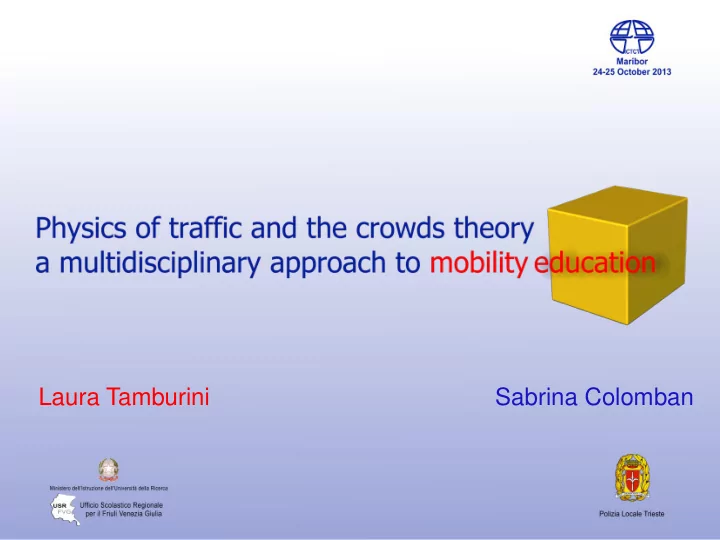

Laura Tamburini Sabrina Colomban
In Italy road safety education is compulsory in all levels’ schools ( Highway Code, art. 230 ) but • teachers do not know how and what to teach students • in primary and secondary school there is the lack of comprehensive mobility education (at least a few hours of traffic safety education into school lessons)
INTERDISCIPLINARY in MOBILITY EDUCATION Project “SicuraMENTE” the mobility education is offered by the schools of Friuli Venezia Giulia (Italy) inside the curricular taught disciplines (2010-2013) by Regional seat of the Ministry of Education in collaboration with: • Municipal Traffic Police of Trieste • Department for Regional Mobility of FVG • FVG Roads Ltd. (managers of State highways in Friuli Venezia Giulia)
Safe and sustainable mobility transversely to • physics • geography • science • citizenship education
Physics and mobility education Context-based Physics Road Safety Education = Context (Michelini, Mossenta, Stefanel, Tamburini, 2012)
Context-based Physics Context and scientific learning are linked in several ways: learning is contextualized (being adapted to the phenomenological context of learning) and motivation for learning implies personal involvement of students which occurs in context (Lave 1988, Taasoobshirazi & Carr 2008)
Education It’s increasingly necessary to provide a large context and in particular scientific kwowledge should be placed not only in subject content related contexts but also in socio-cultural contexts of social kind
Road Safety Education There is a need of designing, proposing, revising the physics learning integrated into social issues Among these a rich context is road safety education , where the scientific concepts play a crucial role What has the role of reference, evocation, application should be the ground to build conceptual knowledge as well as the context of meaning for safety rules
Before our Project “SicuraMENTE” there have been good examples of activities related to context-based physics and concerning traffic safety (Waltner, Wiesner and Rachel 2007; PLON, 1988;Parchmann, Luecken, 2010; Duit, Mikelskis- Seifert and Wodzinski, 2007)
Physical topics Kinematics and dynamic study of motion and relative motions (role of the frame of reference and trajectory; position, displacement and velocity vectors) momentum, sliding and rolling friction Road Safety topics safety distance and human reaction time, dynamic parametres of the motion on the road, sliding and rolling friction on the road
Physics of traffic The crowd produced in a traffic jam is a dynamic entity, a fluid-mechanical system in which physics, mathematics and biology can provide pratical help to understand how and why this problematic situation occurs and what solutions can be found to resolve it Two possible approaches : - the microscopic approach (individual elements) - the macroscopic approach (large-scale system) Analogy between the interaction in the crowds (flock effect, elements repulsion, etc.) and other physical concepts (fluid flow, propagation of shock waves, electron-electron repulsion, etc.)
Background Katsuhiro Nishinari (University of Tokyo, Faculty of Engineering, 2012) Timothy Saunders (European Molecular Biology Laboratory in Heidelberg, 2012) Experimental Situation a route with limited outflow can generate a traffic jam and the crowd of pedestrians can be lightened forcing the crowd in dedicated paths
Without obstacle With obstacle
Experimental design (conduct of the crowd simulating a situation of intense city traffic) Sample two 2 nd classes of junior high school “Campi Elisi” in Trieste 46 students (males and females) 12-13 years old
Setting obstacle = cube 0,70 X 0,70 m area = 24 m 2 students density ~ 0,5/m 2
st step : Walking – Without cube 1 st step : Walking – With cube 1
nd step : Running – Without cube 2 nd step : Running – With cube 2
Experiment data exit time of students crowd from the outlet road ( walking and running , with and without cube)
Results • exit time with cube < exit time without cube counterintuitive physics: an obstacle speeds up the rate of output • running decreases the exit-time, but increases the likelihood of accidents
Explanation of the experiment results to the students
Students Conclusions • High initial speed can produce traffic jams • Not always it needs to be quick in traffic, especially in tight places • High speed increases the risk of collisions
Our Conclusion To make a physical phenomenon experimentally and to be actors of the experiment lets students aware that the correct behaviour in traffic is not imposed, but derives from the laws of physics!
Thank you ! Hvala ! translation by Luisa Mastracchio graphic, photo and video editing by Massimo Conti
Recommend
More recommend